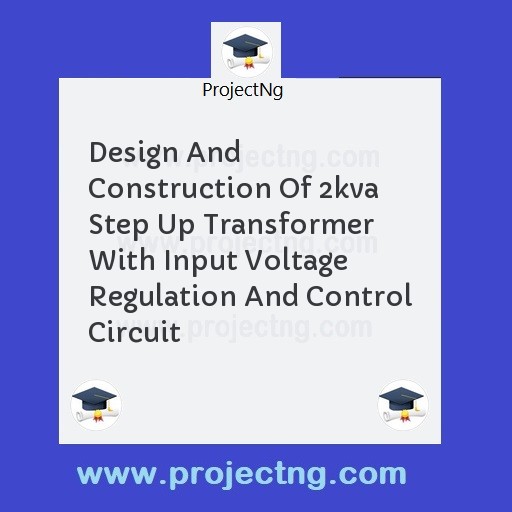Design And Construction Of 2kva Step Up Transformer With Input Voltage Regulation And Control Circuit
Electrical Engineering Project Topics
Get the Complete Project Materials Now! »
DESIGN AND CONSTRUCTION OF 2KVA STEP UP TRANSFORMER WITH INPUT VOLTAGE REGULATION AND CONTROL CIRCUIT
ABSTRACT
This seminar research presents a study on transformer installation, operation and maintenance. A transformer is a static electromagnetic device that transfers energy by inductive coupling between its winding circuits. A transformer is an electrical device that transfers electrical energy between two or more circuits through electromagnetic induction.
CHAPTER ONE
INTRODUCTION
1.1 BACKGROUND OF THE PROJECT
A transformer is a static electromagnetic device that transfers energy by inductive coupling between its winding circuits. In another way, a transformer is an electrical device that transfers electrical energy between two or more circuits through electromagnetic induction. Electromagnetic induction produces an electromotive force within a conductor which is exposed to time varying magnetic fields. A varying current in the primary winding creates a varying magnetic flux in the transformers core and thus a varying magnetic flux through the secondary winding. This varying magnetic flux induces a varying electromotive force (e.m.f) or voltage in the secondary winding. Transformers are used to increase or decrease the alternating voltages in electric power applications. In simple terms, it is an electromagnetic device that steps up or steps down voltages. Making use of Faraday's Law (discovered in 1831) in conjunction with high magnetic permeability core properties, transformers can be designed to efficiently change AC voltages from one voltage level to another within power networks (Gottlieb, 2012.).
A wide range of transformer designs are used in electronics and electric power applications. Transformers are essential for the transmission, distribution and utilization of electric energy. There are many sizes, shapes and configurations of transformers from tiny to gigantic like those used in power transmission. Some come with stubbed out wires, others with screw or spade terminals, some made for mounting in PC boards, others for being screwed or bolted down.
Transformers are composed of a laminated iron core with one or more windings of wire. They are called transformers because they transform voltage and current from one level to another. An alternating current flowing through one coil of wire, the primary, induces a voltage in one or more other coils of wire, the secondary coils. It is the changing voltage of AC current that induces voltage in the other coils through the changing magnetic field. DC voltage such as from a battery or DC power supply will not work in a transformer.

Figure 1.1: A typical Transformer
Only AC makes a transformer work. The magnetic field flows through the iron core. The faster the voltage changes, the higher the frequency (Edward, 2011). However, the output of transformers various from single to double or multiple.
1.2 PROBLEM STATEMENT
This work intends to design and construct 2KVA step up transformer with input voltage regulation and control circuit. Hence, the problems involved in step-up transformer would be solved to ensure efficient and reliable long-term operation. The work will implement a common design rules on a global basis which will be designed and through structured methodology applicable in all phases of transformer production including quotation, electrical and mechanical design, and testing.
1.3 THE AIM AND OBJECTIVES OF THE PROJECT
The aim of this study is to design and construct 2KVA step up transformer with input voltage regulation and control circuit. The objectives are as follows;
1. To design a step up voltage device
2. A well designed and developed regulating and control circuit to monitor the incoming voltage.
To develop a step up transformer with multiple output voltages
3. To build and construct a workable centre tapped step up transformer with input voltage regulation and control circuit.
4. To develop a step up transformer with multiple output voltages
5. To build an economic transformer with multiple output
1.4 SCOPE AND LIMITATION OF PROJECT
The scope of this project is centered on design and construction of step up transformer with multiple output that has these tappings as follows 110V, 80V 12V, 6V. Therefore, the step-up transformer would only work properly for machines and equipment with voltage levels on 110V, 12V, 6V and 3V,
The limitation of the device is that it does not power equipment that is above the level of 110v.
1.5 RELEVANCE OF THE WORK
The relevance of designing the step-up transformer cannot be overemphasized. This is because most electrical or electronic machines and equipment usually comes in various voltages which is solely done by the manufacturer. Also, the voltages as applied to countries are also different. Hence, the step up transformer could be utilized here in Nigeria for different machines and other countries since it is made up of different voltage outputs.
1.6 PROJECT ORGANIZATION
The entire project is arranged in sections to allow proper report presentation and understanding. The first chapter: the introduction; defines some important concepts on the project and gives a brief description of the problems in the society which results in the need for underground cable fault detector, this also contains the objectives, scope and limitations of the project. The second chapter is the review of related literature which describes briefly the history and classification of developed fault location method. Chapter Three highlight design methodology. Chapter Four highlight on the implementation and testing. Chapter Five is all about the conclusions and recommendations.
Be the First to Share On Social

Enjoying our content?
Don't miss out on new videos! Subscribe to our YouTube channel for more awesome content.
Subscribe Now!













